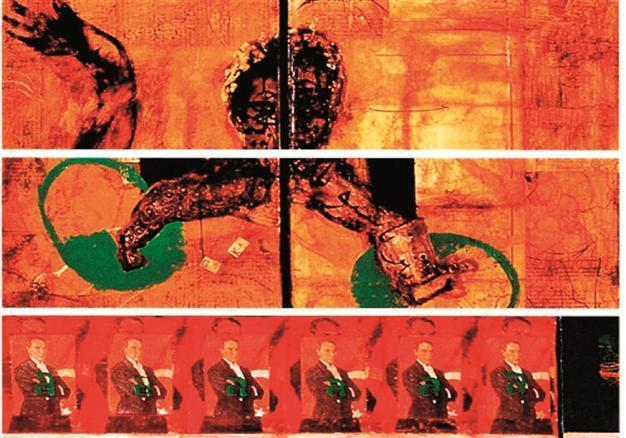Nostalgia for the Modern : State Secularism and Everyday Politics in Turkey
William Armstrong - william.armstrong@hdn.com.tr
 'Nostalgia for the Modern: State Secularism and Everyday Politics in Turkey’ by Esra Özyürek (Duke University Press, 2006, 40TL, pp 240)
'Nostalgia for the Modern: State Secularism and Everyday Politics in Turkey’ by Esra Özyürek (Duke University Press, 2006, 40TL, pp 240)I recently came across a memorable caricature in one of Turkey’s government-supporting newspapers. The box was divided into two cartoons: one showed secular opposition leader Kemal Kılıçdaroğlu driving a quaint 1930s model sports car, squinting at the future in a rather ridiculous brown flat cap; the other showed Prime Minister Recep Tayyip Erdoğan in the cockpit of a 21st century fighter jet, confidently pointing to the sunny horizons of 2023, the 100th anniversary of the republic. The pictures illustrated one apparent contradiction at the heart of modernity in Turkey - sometimes the most “modern” sections of contemporary Turkish society are its religious segments. I’ve met two-time hajjis handling their smart phones with more assurance than I can ever muster. Esra Özyürek’s “Nostalgia for the Modern” examines some of these incongruities, considering the “nostalgia for yesterday’s tomorrow” of secular Kemalists through the prism of the economic transformation that the country has undergone over the last 30 years.
A top-down, state-led understanding of modernization has been a pillar of Kemalism since the beginning of the republic, but the reality is that Turkey’s political paradigms have been steadily redefined by the post-Cold War order. The country’s gradual integration into the global market system has posed an inescapable conundrum to the central etatist convictions held by secular republicans. As Özyürek suggests in this study of contemporary Kemalism: “In the new international order … the basic reference points of nationalist and Kemalist ideology – the boundaries of the national economy, state, and East and West – [are] changing.” So, what happens when a worldview based on the notion of being at the center of state power - and using this power to reshape society - finds itself displaced from central state institutions for a prolonged period of time? Özyürek shows that Kemalists have been forced to revisit expressions of their ideology in a number of unexpected market-orientated ways, even if only unconsciously.
One of the book’s central themes is how the new market paradigm has indirectly infused expressions of popular Kemalism, a process described as a kind of “privatization of state ideology.” In many ways, personalized expressions of politics have become the new basis of citizenship and legitimate political expression, posing something of a paradox for corporatist republicans. A potent example of this is the “exponential increase” in the already ubiquitous images of Atatürk, which Özyürek was astonished to observe on returning to the country after being away for several years. The Atatürk pictures that have seen a sharp rise in popularity of late are not those traditional images in which the modern Turkey’s founder is portrayed as a stern soldier or military leader, but rather those that show him in increasingly personalized settings, as a kind of “jovial bourgeois who enjoyed simple but highly marked pleasures.” The increased production, circulation, and consumption of Atatürk images as an ordinary human with a social life represents a kind of commodification of Kemalist iconography: “Suddenly, it seemed, there was an appropriate picture of Atatürk for every trade: Atatürk at a table for restaurants and bars; several poses of Atatürk drinking coffee for coffee shops; a dancing Atatürk for nightclubs; and even Atatürk with cats and dogs for veterinarians.”
Republican ideology and imagery, which was once defined by its domination of the public sphere, has thus suffused domestic space in a new way. Interestingly, Özyürek identifies this rise in private Kemalist symbolism as partly a reaction against the increased visibility of anti-Kemalist political actors, in particular the appearance of Islam, in the public realm. A kind of “war of symbols” has therefore developed, “the veil and the portrait of Atatürk became symbols of cultural identity through which the two sides of the debate competed with one another in the marketplace.” Market values have triumphed to such an extent that even Kemalists – devotees of a strong, centralized, authoritarian state – engage whole-heartedly in a commodity-based market battle, with the consumption of rival ideological symbols serving as the weapons.
If her book had been written today, Özyürek could also have included references to the neo-Ottoman fad for car sticker sultan tuğras, or the adding of “T.C.” to Facebook profile names – both of which are commercial, public displays of contrasting private ideological convictions. Still, although it was published seven years ago, the points made by “Nostalgia for the Modern” remain relevant to understanding today’s fast-changing Turkey.
Notable recent release

‘The Young Atatürk: From Ottoman Soldier to Statesman of Turkey’ by George Gawrych
(I.B. Tauris, $25, pp 288)










